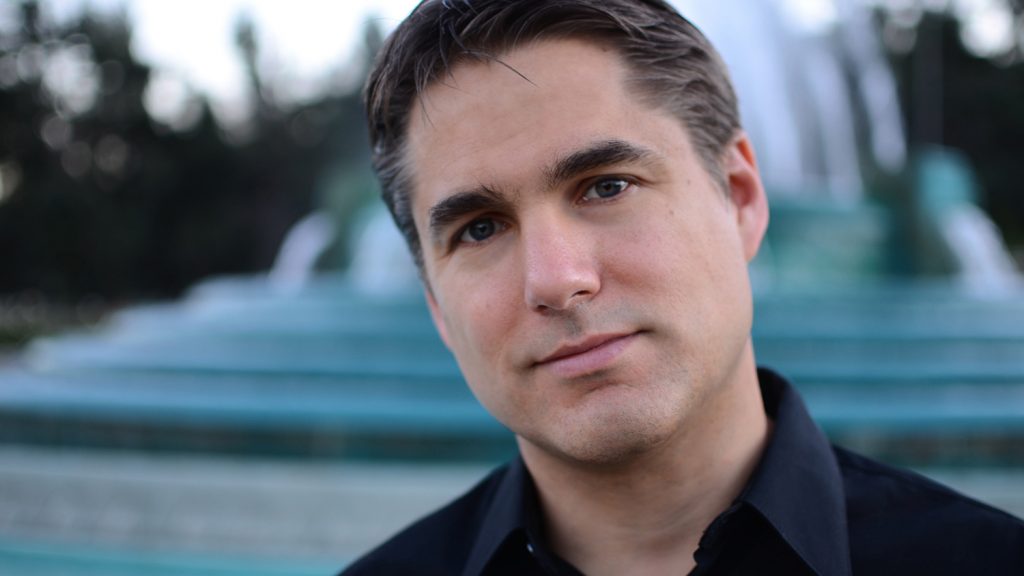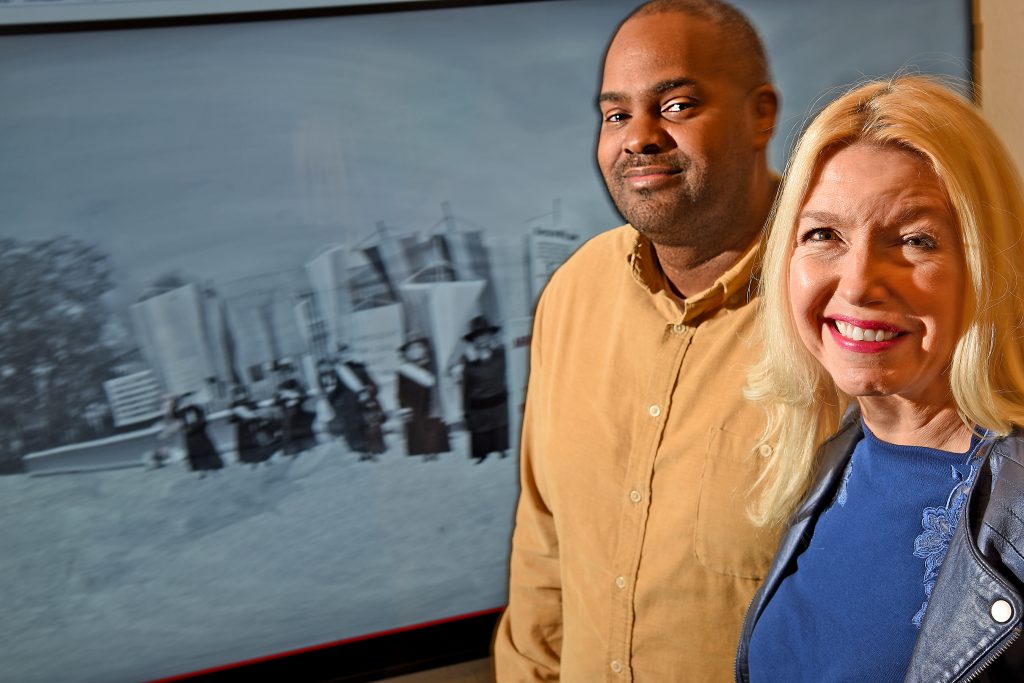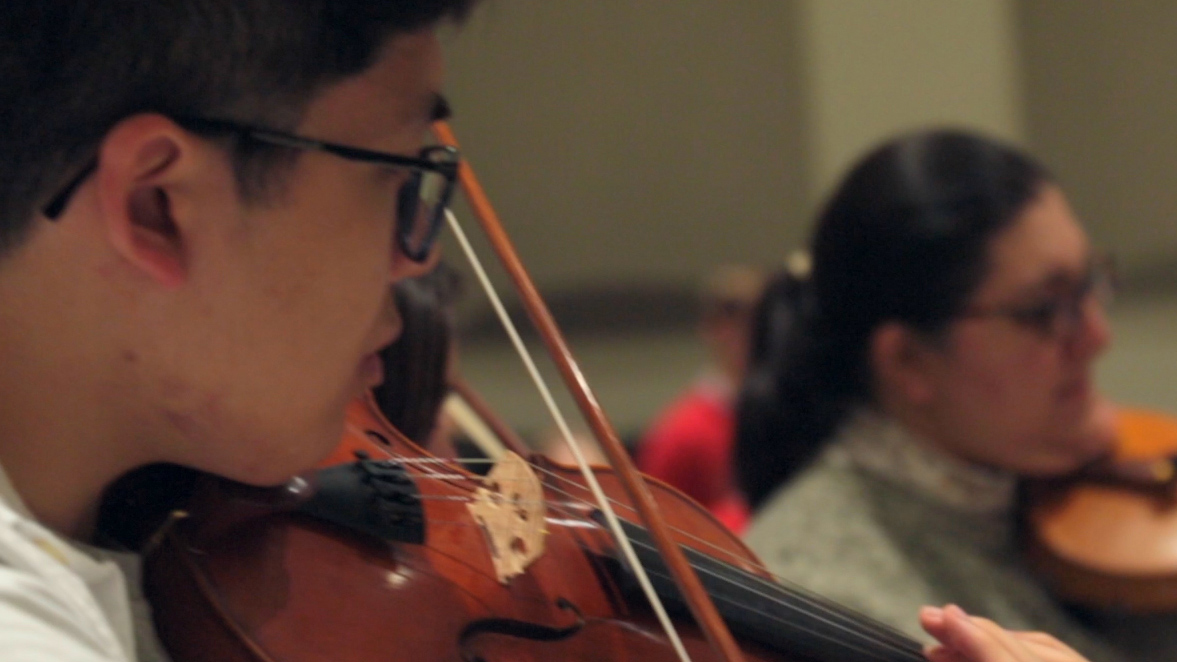Concert Blends VR With Music to Tell Suffrage Story

Imagine a country where women attend college, hold jobs, buy and sell property, engage in political activism, practice law, own businesses and found entire professions — but they can’t vote.
Sound familiar? It’s the United States of America, or at least it was before Congress and three-fourths of the states ratified the 19th Amendment to the Constitution, which prohibited the federal and state governments from denying any citizen the right to vote on the basis of sex. In commemoration of that milestone, an interdisciplinary team of NC State faculty and students have created an event that will feature a symphony orchestra performing music by women composers, combined with a virtual reality experience telling the story of how women fought for, and won, the right to vote.
Our Voices Will Be Heard will take place Sunday, April 14, at 4 p.m. in Stewart Theatre in Talley Student Union. NC State’s Raleigh Civic Symphony will perform pieces by Dame Ethyl Smyth, a 19th-century British composer and suffragette who was jailed for her activism, and Florence Price, the first African American woman to have her music performed by a professional orchestra. The centerpiece of the concert is the world premiere of a new work combining a VR experience with a live symphony orchestra performance.
The first step in creating the revolutionary performance involved Melanie Graham, a lecturer in the Department of English, writing a narrative depicting the struggles and ultimate victory of the suffragette movement. Then Assistant Professor Derek Ham led his graphic design students in producing a VR presentation illustrating Graham’s narrative. Meanwhile, Peter Askim, director of orchestral studies at NC State, commissioned New York composer Aleksandra Vrebalov to work from the same narrative to compose a piece that will express in musical terms what the narrative seeks to convey to the audience.

“I already knew of Derek Ham’s VR work from his I Am a Man presentation,” Askim says. I Am a Man documents the 1968 Memphis sanitation workers’ strike, which landed in the national spotlight when Martin Luther King Jr. arrived in Memphis to support the strikers. Askim and Ham began talking about how they might work together on a project combining VR and music, and Ham mentioned that he wanted to do something related to the upcoming 100th anniversary of the ratification of the 19th Amendment. Askim liked that idea and immediately thought of commissioning Vrebalov to write the orchestral component of the project, both because of her talent as a composer and because of her experience doing multimedia collaborations with world-renowned string ensemble Kronos Quartet.
Then Ham asked Graham if she would like to write a narrative that presents a through line of scenes depicting the people and events of the suffrage movement. The two already knew each other, again because of Ham’s I Am a Man piece.
“After I saw I Am a Man, I was so impressed that I emailed Derek right away and asked if I could work with him on any level,” Graham says. “When he wrote me back with a one-sentence email asking if I would be interested in working on a suffrage project, that was one sentence that changed my life. I thought, this is a dream for me. And it has been.”
“Collaborating with faculty in other disciplines on this project catalyzes the dream of what NC State is all about,” Ham says.
“Collaborating with faculty in other disciplines on this project catalyzes the dream of what NC State is all about.”
Once Graham was on board with the project, Ham assigned some of his graduate design students to research the suffrage movement, flesh out a timeline and assemble ideas for themes to convey and images to use. Then Graham used their research as the basis for a series of vignettes telling a compressed version of the movement’s history.

“Essentially, Derek and Peter said we have about 100 years of suffragette history, and we need you to write a narrative that will cover it in 20 minutes,” Graham says with a laugh. “After I started doing research, it really formed like a movie in my mind, especially when I started researching less well-known figures in the movement, like Ida B. Wells. She was an African American suffragette who also fought the KKK. I was thrilled to incorporate her into the narrative.”
When Graham’s narrative was complete, Askim sent it to Vrebalov so she could use it as the basis for her composition.
“Alex is a very thoughtful, philosophical, spiritual composer,” Askim says. “She wanted to take this idea of voting, of voices being heard in a democracy, and use it to create a score that allows musicians to make their own decisions and contributions through structured improvisation.”
In addition, the score calls for the orchestra’s musicians to be distributed in groups throughout Stewart Theatre, providing an immersive auditory experience to accompany the VR presentation’s 360-degree visuals.
While Vrebalov was composing the score, Ham set his sophomore graphic design students to work creating scenes to bring Graham’s narrative to life through VR.
“What I hope my students get out of this experience is being stretched beyond their comfort zone,” Ham says. “If you think about what graphic designers classically do, they work within a rectilinear box. Think about a website, a business card, a poster, and so on — everything’s rectilinear. Now I’m presenting students with the challenge of designing content that’s not only animated, but it’s spatial. It makes them think about design in a way that will give them a new set of skills and help them to be stronger designers.”
After Ham’s undergrads finished creating the VR scenes, his graduate students did the final editing to stitch them all together into the presentation concertgoers will see on April 14.
“Every single person at the concert will have a different experience,” Askim says. “Each person controls their own experience of the VR. And then one person might be sitting closer to the violins, while another might be sitting closer to the percussion. And yet it’s all working in harmony. I’m excited for our audience to experience that.”
Every single person at the concert will have a different experience.
To participate in the VR experience, attendees will need to bring a smartphone and connect it to Stewart Theatre’s WiFi network or their own Internet service provider. Cardboard headsets will be handed out at the door along with printed instructions for accessing and viewing the VR presentation. Student assistants will also be present to help audience members who need assistance with the headsets or viewing the presentation. NC State’s Sustainability Fund provided a grant allowing the Department of Music to purchase the headsets.
Due to the facility’s signal limitations, the cardboard headsets and access to WiFi will be limited to the first 300 audience members who request them. The visual component of the program will also be projected on a large screen onstage.
Prior to the concert, there will be a free panel discussion in which faculty members will engage in conversation with each other and the audience about issues concerning gender, race, justice and technology. The discussion will take place in room 3222 of Talley Student Union at 2 p.m. Then at 3 p.m. a civic engagement showcase in the lobby outside Stewart Theatre will feature a variety of on- and off-campus groups presenting exhibits and information tables on voting, gender, racial equality, social justice and innovative technology. For more information on the panel discussion and informational exhibits, visit the concert’s event page.
Tickets to the concert cost $5 for NC State students; $10 for faculty, staff, seniors and other students; and $12 for general admission. Children younger than 12 are admitted free of charge. Tickets can be purchased online or in advance through Ticket Central at 919-515-1100 (1-6 p.m. Monday-Friday).
This post was originally published in NC State News.



